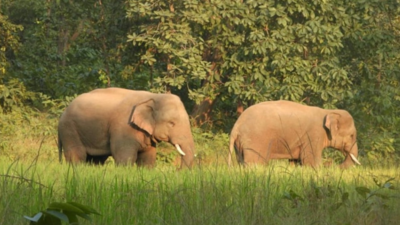
RAIPUR: Following recent deaths of elephants from electrocution and train accidents, the Chhattisgarh Forest Department plan to add’Haathi Sign App‘ with advanced features for electrical and railway mapping.
The upgrade will incorporate contact details of railway and electricity department staff to prevent mishaps. A new version will be released soon.
Haathi Alert AI App now includes GIS layer of railway and power infrastructure. The forest department collected the contact information of station masters and electricity department staff working in the forest division to be integrated into the mapping system.
Staff members will receive notifications when elephant herds enter certain zones, especially within two to three kilometers of power lines and railway tracks.
The electrical personnel will verify the proper height of the wires, while the station master will alert the train driver about the elephant in the corridor. The train operator will then reduce the speed to ensure the safety of the elephants.
GPS mapping of power lines will be integrated into the app’s GIS layer. AI-powered alerts via phone calls, SMS, and WhatsApp will notify the electricity and forest departments when elephants approach power lines.
This system will help identify hazards in elephant corridors, including low hanging wires, unstable poles, and illegal fences. Officials can monitor the location of elephants and power infrastructure through the app.
Train track GIS data from Google Maps will be integrated into the system. The alert will notify the relevant staff when an elephant is detected within one kilometer. Staff must register with the Alert App for this function.
“Infrastructure mapping has been completed, and the app will include a manual power line entry option. Upgrading the system should be completed within a month,” said a senior forest official.
The Chhattisgarh Forest Department has implemented comprehensive measures to reduce human-elephant conflict, promote peaceful coexistence through technology, community involvement, and administrative measures in elephant migration areas.
Chief Conservator of Forests and Head of Forest Force V Sreenivasa Rao said, “The Forest Department is dedicated to reducing elephant and human casualties, besides protecting livelihoods, and ensuring harmonious coexistence between humans and elephants.”
Katghora forest division has 40-60 permanent elephant population in various ranges, while 90-110 elephants migrate through Dharamjaigarh division. Elephants have established a permanent presence in several ranges of the Surajpur forest division.
Among the many initiatives taken by the department to prevent casualties due to human-elephant conflict is the use of technological solutions, including ODK (open data kit) Collecting and the Elephant Tracker application for real-time monitoring.
A control room equipped with thermal drones and night vision devices ensures continuous surveillance, regular inspections of power lines prevent electrical risks, and warning signs and awareness materials are installed in affected areas.
Community engagement initiatives include awareness programs through Gaj Yatra and daily patrols by Hathi Mitr Dal. Forest staff provide protection during festivals and critical events, ensuring public safety in elephant-prone areas.
Special protection measures are in place during elections and other events. Forest personnel help safely escort residents through elephant-prone areas. Farmers receive guidance on crop scheduling to minimize crop damage.
Through these comprehensive measures, the department continues to strive for sustainable coexistence between humans and elephants in their shared territory. Apps like ODK Collect (can be used without internet) and Elephant Tracker enable real-time updates on elephant movements, with nearby villagers notified via phone calls and messages. Sajak’s Alarm System ensures timely alerts when it appears to be notified via the app.
Katghora DFO Kumar Nishant highlighted, “During the last six months, elephants have been regularly monitored at 133 locations through this application. The department is maintaining special vigilance at these sites to minimize damage.”
In Pratapur, efforts were made to ensure that Chhath Vrati’s mother returned home safely after the ritual. In Dharamjaigarh, a district-level wildlife protection committee, guided by the District Collector, is formulating a security strategy.
The compensation mechanism has been simplified to efficiently deal with crop and property damage. Surajpur DFO Pankaj Kamal noted, “In 2024, a compensation case of around Rs 72 lakh for crop damage has been prepared and paid so far.”
Also, Dharamjaigarh DFO Abhishek Jogawat said, “During the last two years, a total compensation of Rs 2,16,58,445 has been disbursed in the Dharamjaigarh Forest Division to deal with cases of human loss, injury, crop damage, and property damage.”
Jogawat shared, “For the past two years, the Forest Department has escorted 78 people in Dharamjaigarh forest, 21 people in Chhal forest, and 2 people in Kapu forest to their homes.”
Farmers are also advised to speed up rice harvesting in areas with potential elephant activity to reduce damage.
Meanwhile, a larger herd of 90-110 elephants is active across Chaal and Dharamjaigarh forests in Dharamjagarh division.
In the Surajpur forest division, elephants have settled permanently in Pratapur, Ghui, Ramanujnagar, and Biharpur forests.




